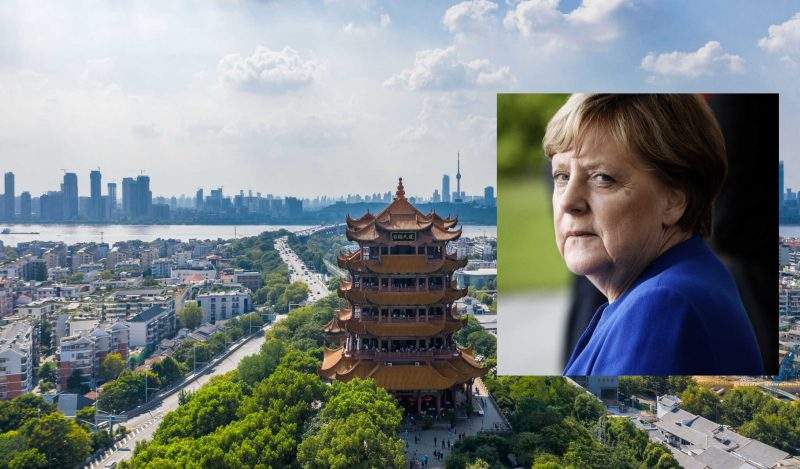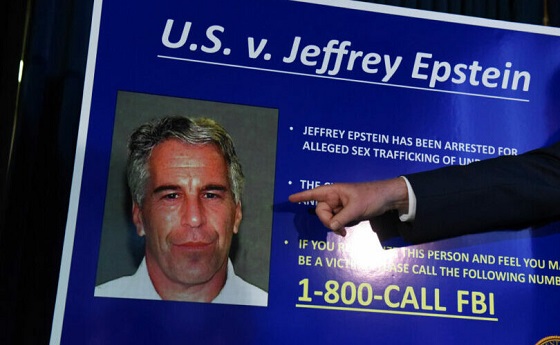Brownstone Institute
Curious: Angela Merkel’s September 2019 Visit to Wuhan

From the Brownstone Institute
BY
In a much-tweeted soundbite from the recent Congressional hearing on the origins of Covid-19, former CDC director Robert Redfield noted that three unusual events occurred in Wuhan in September 2019 suggesting a lab leak from the Wuhan Institute of Virology (WIV).
But another, in retrospect, highly curious event also occurred in Wuhan in September 2019: namely, none other than then German Chancellor Angela Merkel paid a visit to the city and, more specifically, to the Tongji Hospital on the left bank of the Yangtze River. The hospital is also known as the German-Chinese Friendship Hospital.
The below photo from Germany’s Deutsche Presse Agentur shows Chancellor Merkel being greeted by nurses at the hospital reception on September 7, 2019. (Source: Süddeutsche Zeitung.)

A 2021 House Foreign Affairs Committee Minority Report, referring in greater detail to the same events as Redfield, concludes that a lab leak took place at the WIV sometime prior to September 12, when, notably, the WIV’s virus and sample database was mysteriously taken offline in the middle of the night (p. 5 and passim).
What an incredible coincidence that the German Chancellor was visiting Wuhan’s Tongji Hospital at almost precisely the time when, according to Redfield’s speculations, a potentially catastrophic event was taking place across the river at the Wuhan Institute of Virology! This was, moreover, merely three months before the first officially acknowledged cases of Covid-19 began to turn up in the city.
But the coincidence is in fact even more incredible. For when those first cases did begin to turn up in Wuhan in early December 2019, they did not in fact turn up in the vicinity of the Wuhan Institute of Virology on the right bank of the Yangtze, but rather in the direct vicinity of Tongji Hospital on the left bank!
The below mapping of the initial cluster of cases from Science magazine makes this clear. The black dot is the epicenter of the cluster. Cross #5 marks the location of Tongji Hospital.

And that is not all. As discussed in my earlier article on “The Other Lab in Wuhan,”although the WIV was relatively far removed from the outbreak – say around 10 kilometers from the epicenter as the crow flies — there is in fact another virus research lab in Wuhan that is located right in the area of the initial cluster.
The lab in question is the German-Chinese Joint Laboratory of Infection and Immunity – or, as its German co-director Ulf Dittmer has also called it, the “Essen-Wuhan Laboratory for Virus Research” – and the Chinese host institution of the German-Chinese Joint Lab is none other than the Tongji-Hospital-affiliated Tongji Medical College.
Per Google maps, Tongji Medical College is located around one kilometer due north of the hospital. Have another look at the above map keeping in mind the indicated scale. This would put it nearly right at the epicenter of the outbreak!
According to German and Chinese sources, however, the lab is in fact located at another hospital affiliated with Tongji Medical College: Wuhan Union Hospital. The location of Union Hospital is marked by cross #6 on the Science map: still in the cluster, but a bit further away from the epicenter.
A press release on the website of the University of Duisburg-Essen, the German co-sponsor of the lab, notes that:
The Joint Lab is fully equipped for virus research. It is a BSL2 safety laboratory with access to BSL3 conditions. German and Chinese members of the lab have access to a large sample collection form [sic.] patients of the Department of Infectious Diseases for their research.
BSL stands for “biosafety level.”
The below photo from a German article on the Essen-Wuhan collaboration shows the virologist Xin Zheng of Union Hospital, Tongji Medical School, at work in the joint lab. Per the cited source, Xin did her doctorate at the University of Duisburg-Essen.

Could SARS-CoV-2 have leaked from the joint lab?
And, while we’re at it, was gain-of-function research being conducted at the lab? We do not know, but we do know that the German members of the lab will, at any rate, have been in contact with a nearby lab where it was being conducted. For the Wuhan Institute of Virology lists the University of Duisburg-Essen as one of its partner institutions.

Furthermore, in addition to its own partnership with the University of Duisburg-Essen, Tongji Medical College also has a longstanding academic exchange program with the Charité research and teaching hospital in Berlin of none other than Christian Drosten: the German virologist whose controversial and ultrasensitive PCR protocol, in effect, guaranteed that the Covid-19 outbreak would acquire the status of a “pandemic.”
As discussed in “The Other Lab in Wuhan,” Drosten appears as one of the scientists participating in the so-called “Fauci emails,” and of all the participants, he is the most vehement denier of the possibility of a lab leak.
In remarks in the German press, Drosten has admitted that he began working on his Covid-19 testing protocol before any Covid-19 cases had even officially been reported to the WHO! He says he did so based on information he had from unnamed virologist colleagues working in Wuhan. (Source: Die Berliner Zeitung.)
Speaking of which, Drosten can be seen below in the company of none other than Shi Zhengli of the Wuhan Institute of Virology, the scientist whose research on bat coronaviruses is suspected of being at the origin of a Covid-19 lab leak.

The picture comes from a “Sino-German Symposium on Infectious Diseases” that took place in Berlin in 2015 and that was organized by Ulf Dittmer of the University of Duisburg-Essen. Dittmer, as noted above, is the co-director of the Essen-Wuhan lab, which would be founded two years later. The symposium was funded by the German Ministry of Health.
Dittmer is the bald man with the striped shirt in the full group picture of symposium participants below. (Source: University of Duisburg-Essen.) The jovial bearded man with the bowtie in the next row is none other than Thomas Mertens, the current chair of the “Standing Committee on Vaccination” of the German health authority, the Robert Koch Institute.

The Berlin symposium was held one year after the US government declared a moratorium on gain-of-function research.
As it so happens, Drosten himself has been involved in gain-of-function research, as the below screen shot from the webpage of the German RAPID project makes clear.

RAPID stands for “Risk Assessment in Prepandemic Respiratory Infectious Diseases.” Further information from the German Ministry of Education and Research expressly states that Drosten’s Charité hospital does not merely oversee, but is directly involved (beteiligt) in RAPID sub-project 2: i.e. “identification of host factors by loss-of-function and gain-of-function experiments.”
Imagine for a moment that then President Donald Trump paid a visit to Wuhan in September 2019, at the very time that a lab leak is suspected to have occurred in the city.
And imagine that, while there, he made a stop at a hospital that is affiliated with a medical school located in the very epicenter of the Covid-19 outbreak that would officially occur three months later.
Imagine that this medical school, furthermore, runs a joint, BSL-3 capable, virus research lab with an American university – let’s say, for example, Ralph Baric’s University of North Carolina – and that Baric and his colleagues were themselves conducting research right in Wuhan!
And imagine that the American university in question is also a partner institution of the Wuhan Institute of Virology (Baric’s University of North Carolina is not in fact) and that the local Wuhan medical school also has a partnership with, say, the NIH.
And imagine that there is even a photo of none other than Anthony Fauci of the NIH with none other than Shi Zhengli of the Wuhan Institute of Virology at a joint “Sino-American Symposium on Infectious Diseases” in Washington that was organized by Baric and funded by the US Department of Health four years before the Covid-19 outbreak. And imagine, for good measure, that, say, Rochelle Walensky was also present at the event.
Imagine, finally, that Fauci had not just (allegedly) provided funding for gain-of-function research, but was himself directly involved in it.
The above concatenation of circumstances would undoubtedly be regarded as what some members of the US intelligence community might call “slam-dunk” proof of US complicity in any lab leak of the SARS-CoV-2 virus that may have occurred in Wuhan.
Why does the ample evidence of manifold German connections to and indeed involvement in virus research in Wuhan not merit at least the same degree of scrutiny, if not to say of certainty?
Brownstone Institute
Net Zero: The Mystery of the Falling Fertility

From the Brownstone Institute
By
If you want to argue that a mysterious factor X is responsible for the drop in fertility, you will have to explain (1) why the factor affected only the vaccinated, and (2) why it started affecting them at about the time of vaccination.
In January 2022, the number of children born in the Czech Republic suddenly decreased by about 10%. By the end of 2022, it had become clear that this was a signal: All the monthly numbers of newborns were mysteriously low.
In April 2023, I wrote a piece for a Czech investigative platform InFakta and suggested that this unexpected phenomenon might be connected to the aggressive vaccination campaign that had started approximately 9 months before the drop in natality. Denik N – a Czech equivalent of the New York Times – immediately came forward with a “devastating takedown” of my article, labeled me a liar and claimed that the pattern can be explained by demographics: There were fewer women in the population and they were getting older.
To compare fertility across countries (and time), the so-called Total Fertility Rate (TFR) is used. Roughly speaking, it is the average number of children that are born to a woman over her lifetime. TFR is independent of the number of women and of their age structure. Figure 1 below shows the evolution of TFR in several European countries between 2001 and 2023. I selected countries that experienced a similar drop in TFR in 2022 as the Czech Republic.

So, by the end of 2023, the following two points were clear:
- The drop in natality in the Czech Republic in 2022 could not be explained by demographic factors. Total fertility rate – which is independent of the number of women and their age structure – dropped sharply in 2022 and has been decreasing ever since. The data for 2024 show that the Czech TFR has decreased further to 1.37.
- Many other European countries experienced the same dramatic and unexpected decrease in fertility that started at the beginning of 2022. I have selected some of them for Figure 1 but there are more: The Netherlands, Norway, Slovakia, Slovenia, and Sweden. On the other hand, there are some countries that do not show a sudden drop in TFR, but rather a steady decline over a longer period (e.g. Belgium, France, UK, Greece, or Italy). Notable exceptions are Bulgaria, Spain, and Portugal where fertility has increased (albeit from very low numbers). The Human Fertility Project database has all the numbers.
This data pattern is so amazing and unexpected that even the mainstream media in Europe cannot avoid the problem completely. From time to time, talking heads with many academic titles appear and push one of the politically correct narratives: It’s Putin! (Spoiler alert: The war started in February 2022; however, children not born in 2022 were not conceived in 2021). It’s the inflation caused by Putin! (Sorry, that was even later). It’s the demographics! (Nope, see above, TFR is independent of the demographics).
Thus, the “v” word keeps creeping back into people’s minds and the Web’s Wild West is ripe with speculation. We decided not to speculate but to wrestle some more data from the Czech government. For many months, we were trying to acquire the number of newborns in each month, broken down by age and vaccination status of the mother. The post-socialist health-care system of our country is a double-edged sword: On one hand, the state collects much more data about citizens than an American would believe. On the other hand, we have an equivalent of the FOIA, and we are not afraid to use it. After many months of fruitless correspondence with the authorities, we turned to Jitka Chalankova – a Czech Ron Johnson in skirts – who finally managed to obtain an invaluable data sheet.
To my knowledge, the datasheet (now publicly available with an English translation here) is the only officially released dataset containing a breakdown of newborns by the Covid-19 vaccination status of the mother. We requested much more detailed data, but this is all we got. The data contains the number of births per month between January 2021 and December 2023 given by women (aged 18-39) who were vaccinated, i.e., had received at least one Covid vaccine dose by the date of delivery, and by women who were unvaccinated, i.e., had not received any dose of any Covid vaccine by the date of delivery.
Furthermore, the numbers of births per month by women vaccinated by one or more doses during pregnancy were provided. This enabled us to estimate the number of women who were vaccinated before conception. Then, we used open data on the Czech population structure by age, and open data on Covid vaccination by day, sex, and age.
Combining these three datasets, we were able to estimate the rates of successful conceptions (i.e., conceptions that led to births nine months later) by preconception vaccination status of the mother. Those interested in the technical details of the procedure may read Methods in the newly released paper. It is worth mentioning that the paper had been rejected without review in six high-ranking scientific journals. In Figure 2, we reprint the main finding of our analysis.

Figure 2 reveals several interesting patterns that I list here in order of importance:
- Vaccinated women conceived about a third fewer children than would be expected from their share of the population. Unvaccinated women conceived at about the same rate as all women before the pandemic. Thus, a strong association between Covid vaccination status and successful conceptions has been established.
- In the second half of 2021, there was a peak in the rate of conceptions of the unvaccinated (and a corresponding trough in the vaccinated). This points to rather intelligent behavior of Czech women, who – contrary to the official advice – probably avoided vaccination if they wanted to get pregnant. This concentrated the pregnancies in the unvaccinated group and produced the peak.
- In the first half of 2021, there was significant uncertainty in the estimates of the conception rates. The lower estimate of the conception rate in the vaccinated was produced by assuming that all women vaccinated (by at least one dose) during pregnancy were unvaccinated before conception. This was almost certainly true in the first half of 2021 because the vaccines were not available prior to 2021. The upper estimate was produced by assuming that all women vaccinated (by at least one dose) during pregnancy also received at least one dose before conception. This was probably closer to the truth in the second part of 2021. Thus, we think that the true conception rates for the vaccinated start close to the lower bound in early 2021 and end close to the upper bound in early 2022. Once again, we would like to be much more precise, but we have to work with what we have got.
Now that the association between Covid-19 vaccination and lower rates of conception has been established, the one important question looms: Is this association causal? In other words, did the Covid-19 vaccines really prevent women from getting pregnant?
The guardians of the official narrative brush off our findings and say that the difference is easily explained by confounding: The vaccinated tend to be older, more educated, city-dwelling, more climate change aware…you name it. That all may well be true, but in early 2022, the TFR of the whole population dropped sharply and has been decreasing ever since.
So, something must have happened in the spring of 2021. Had the population of women just spontaneously separated into two groups – rednecks who wanted kids and didn’t want the jab, and city slickers who didn’t want kids and wanted the jab – the fertility rate of the unvaccinated would indeed be much higher than that of the vaccinated. In that respect, such a selection bias could explain the observed pattern. However, had this been true, the total TFR of the whole population would have remained constant.
But this is not what happened. For some reason, the TFR of the whole population jumped down in January 2022 and has been decreasing ever since. And we have just shown that, for some reason, this decrease in fertility affected only the vaccinated. So, if you want to argue that a mysterious factor X is responsible for the drop in fertility, you will have to explain (1) why the factor affected only the vaccinated, and (2) why it started affecting them at about the time of vaccination. That is a tall order. Mr. Occam and I both think that X = the vaccine is the simplest explanation.
What really puzzles me is the continuation of the trend. If the vaccines really prevented conception, shouldn’t the effect have been transient? It’s been more than three years since the mass vaccination event, but fertility rates still keep falling. If this trend continues for another five years, we may as well stop arguing about pensions, defense spending, healthcare reform, and education – because we are done.
We are in the middle of what may be the biggest fertility crisis in the history of mankind. The reason for the collapse in fertility is not known. The governments of many European countries have the data that would unlock the mystery. Yet, it seems that no one wants to know.
Author
Brownstone Institute
FDA Exposed: Hundreds of Drugs Approved without Proof They Work

From the Brownstone Institute
By
The US Food and Drug Administration (FDA) has approved hundreds of drugs without proof that they work—and in some cases, despite evidence that they cause harm.
That’s the finding of a blistering two-year investigation by medical journalists Jeanne Lenzer and Shannon Brownlee, published by The Lever.
Reviewing more than 400 drug approvals between 2013 and 2022, the authors found the agency repeatedly ignored its own scientific standards.
One expert put it bluntly—the FDA’s threshold for evidence “can’t go any lower because it’s already in the dirt.”
A System Built on Weak Evidence
The findings were damning—73% of drugs approved by the FDA during the study period failed to meet all four basic criteria for demonstrating “substantial evidence” of effectiveness.
Those four criteria—presence of a control group, replication in two well-conducted trials, blinding of participants and investigators, and the use of clinical endpoints like symptom relief or extended survival—are supposed to be the bedrock of drug evaluation.
Yet only 28% of drugs met all four criteria—40 drugs met none.
These aren’t obscure technicalities—they are the most basic safeguards to protect patients from ineffective or dangerous treatments.
But under political and industry pressure, the FDA has increasingly abandoned them in favour of speed and so-called “regulatory flexibility.”
Since the early 1990s, the agency has relied heavily on expedited pathways that fast-track drugs to market.
In theory, this balances urgency with scientific rigour. In practice, it has flipped the process. Companies can now get drugs approved before proving that they work, with the promise of follow-up trials later.
But, as Lenzer and Brownlee revealed, “Nearly half of the required follow-up studies are never completed—and those that are often fail to show the drugs work, even while they remain on the market.”
“This represents a seismic shift in FDA regulation that has been quietly accomplished with virtually no awareness by doctors or the public,” they added.
More than half the approvals examined relied on preliminary data—not solid evidence that patients lived longer, felt better, or functioned more effectively.
And even when follow-up studies are conducted, many rely on the same flawed surrogate measures rather than hard clinical outcomes.
The result: a regulatory system where the FDA no longer acts as a gatekeeper—but as a passive observer.
Cancer Drugs: High Stakes, Low Standards
Nowhere is this failure more visible than in oncology.
Only 3 out of 123 cancer drugs approved between 2013 and 2022 met all four of the FDA’s basic scientific standards.
Most—81%—were approved based on surrogate endpoints like tumour shrinkage, without any evidence that they improved survival or quality of life.
Take Copiktra, for example—a drug approved in 2018 for blood cancers. The FDA gave it the green light based on improved “progression-free survival,” a measure of how long a tumour stays stable.
But a review of post-marketing data showed that patients taking Copiktra died 11 months earlier than those on a comparator drug.
It took six years after those studies showed the drug reduced patients’ survival for the FDA to warn the public that Copiktra should not be used as a first- or second-line treatment for certain types of leukaemia and lymphoma, citing “an increased risk of treatment-related mortality.”
Elmiron: Ineffective, Dangerous—And Still on the Market
Another striking case is Elmiron, approved in 1996 for interstitial cystitis—a painful bladder condition.
The FDA authorized it based on “close to zero data,” on the condition that the company conduct a follow-up study to determine whether it actually worked.
That study wasn’t completed for 18 years—and when it was, it showed Elmiron was no better than placebo.
In the meantime, hundreds of patients suffered vision loss or blindness. Others were hospitalized with colitis. Some died.
Yet Elmiron is still on the market today. Doctors continue to prescribe it.
“Hundreds of thousands of patients have been exposed to the drug, and the American Urological Association lists it as the only FDA-approved medication for interstitial cystitis,” Lenzer and Brownlee reported.
“Dangling Approvals” and Regulatory Paralysis
The FDA even has a term—”dangling approvals”—for drugs that remain on the market despite failed or missing follow-up trials.
One notorious case is Avastin, approved in 2008 for metastatic breast cancer.
It was fast-tracked, again, based on ‘progression-free survival.’ But after five clinical trials showed no improvement in overall survival—and raised serious safety concerns—the FDA moved to revoke its approval for metastatic breast cancer.
The backlash was intense.
Drug companies and patient advocacy groups launched a campaign to keep Avastin on the market. FDA staff received violent threats. Police were posted outside the agency’s building.
The fallout was so severe that for more than two decades afterwards, the FDA did not initiate another involuntary drug withdrawal in the face of industry opposition.
Billions Wasted, Thousands Harmed
Between 2018 and 2021, US taxpayers—through Medicare and Medicaid—paid $18 billion for drugs approved under the condition that follow-up studies would be conducted. Many never were.
The cost in lives is even higher.
A 2015 study found that 86% of cancer drugs approved between 2008 and 2012 based on surrogate outcomes showed no evidence that they helped patients live longer.
An estimated 128,000 Americans die each year from the effects of properly prescribed medications—excluding opioid overdoses. That’s more than all deaths from illegal drugs combined.
A 2024 analysis by Danish physician Peter Gøtzsche found that adverse effects from prescription medicines now rank among the top three causes of death globally.
Doctors Misled by the Drug Labels
Despite the scale of the problem, most patients—and most doctors—have no idea.
A 2016 survey published in JAMA asked practising physicians a simple question—what does FDA approval actually mean?
Only 6% got it right.
The rest assumed that it meant the drug had shown clear, clinically meaningful benefits—such as helping patients live longer or feel better—and that the data was statistically sound.
But the FDA requires none of that.
Drugs can be approved based on a single small study, a surrogate endpoint, or marginal statistical findings. Labels are often based on limited data, yet many doctors take them at face value.
Harvard researcher Aaron Kesselheim, who led the survey, said the results were “disappointing, but not entirely surprising,” noting that few doctors are taught about how the FDA’s regulatory process actually works.
Instead, physicians often rely on labels, marketing, or assumptions—believing that if the FDA has authorized a drug, it must be both safe and effective.
But as The Lever investigation shows, that is not a safe assumption.
And without that knowledge, even well-meaning physicians may prescribe drugs that do little good—and cause real harm.
Who Is the FDA Working for?
In interviews with more than 100 experts, patients, and former regulators, Lenzer and Brownlee found widespread concern that the FDA has lost its way.
Many pointed to the agency’s dependence on industry money. A BMJ investigation in 2022 found that user fees now fund two-thirds of the FDA’s drug review budget—raising serious questions about independence.

Yale physician and regulatory expert Reshma Ramachandran said the system is in urgent need of reform.
“We need an agency that’s independent from the industry it regulates and that uses high-quality science to assess the safety and efficacy of new drugs,” she told The Lever. “Without that, we might as well go back to the days of snake oil and patent medicines.”
For now, patients remain unwitting participants in a vast, unspoken experiment—taking drugs that may never have been properly tested, trusting a regulator that too often fails to protect them.
And as Lenzer and Brownlee conclude, that trust is increasingly misplaced.
- Investigative report by Jeanne Lenzer and Shannon Brownlee at The Lever [link]
- Searchable public drug approval database [link]
- See my talk: Failure of Drug Regulation: Declining standards and institutional corruption
Republished from the author’s Substack
-

 Also Interesting2 days ago
Also Interesting2 days ago9 Things You Should Know About PK/PD in Drug Research
-

 Business2 days ago
Business2 days agoCannabis Legalization Is Starting to Look Like a Really Dumb Idea
-

 Bruce Dowbiggin1 day ago
Bruce Dowbiggin1 day agoThe Covid 19 Disaster: When Do We Get The Apologies?
-

 Business2 days ago
Business2 days ago‘Experts’ Warned Free Markets Would Ruin Argentina — Looks Like They Were Dead Wrong
-

 Media2 days ago
Media2 days agoCBC journalist quits, accuses outlet of anti-Conservative bias and censorship
-

 Business1 day ago
Business1 day agoCarney government should recognize that private sector drives Canada’s economy
-

 Automotive2 days ago
Automotive2 days agoAmerica’s EV Industry Must Now Compete On A Level Playing Field
-

 Alberta1 day ago
Alberta1 day agoFourteen regional advisory councils will shape health care planning and delivery in Alberta








